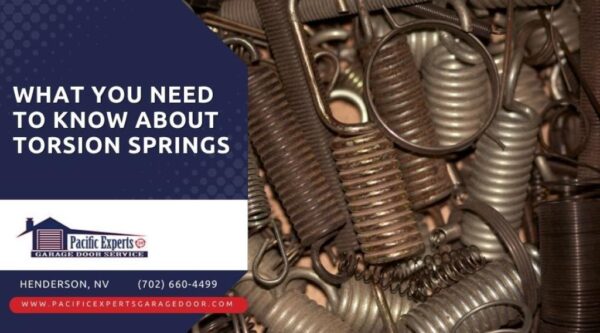Torsion springs are a crucial component in various mechanical systems, providing rotational force or torque. Whether you're a DIY enthusiast, a homeowner, or a professional in the field, understanding the basics of torsion springs is essential. In this article, we will explore the different types of torsion springs, factors to consider when choosing them, their installation and maintenance, safety considerations, and the advantages and disadvantages they offer. Additionally, we will highlight Pacific Experts Garage Door as a reliable source for high-quality torsion springs. So let's dive in and uncover the world of torsion springs!
- Types of Torsion Springs
- Factors to Consider When Choosing Torsion Springs
- Installation and Maintenance of Torsion Springs
- Torsion Springs: Safety Considerations
- Advantages and Disadvantages of Torsion Springs
- Torsion Springs are available at Pacific Experts Garage Door
- FAQs
- Are torsion springs interchangeable between different applications?
- Can I adjust the tension of a torsion spring on my own?
- How often should torsion springs be inspected?
- Can I use lubricants other than those recommended by the manufacturer?
- What should I do if a torsion spring breaks?
Types of Torsion Springs
Torsion springs come in various types, each designed to meet specific requirements. Here are some common types:
- Single Torsion Springs: Single torsion springs consist of a coiled wire wound around a central shaft. They exert torque in one direction, resisting rotational force applied to the opposite side. Single torsion springs are commonly used in garage doors, clothespins, and various automotive applications.
- Double Torsion Springs: Double torsion springs are similar to single torsion springs but have two coils wound in opposite directions. They provide torque in both clockwise and counterclockwise directions, making them suitable for applications that require bidirectional force, such as swing gates and balance scales.
- Close-Wound Torsion Springs: Close-wound torsion springs have tightly coiled wire, with each turn touching the adjacent one. They offer high torque in a compact size and are commonly used in applications where space is limited, such as in electronics, medical devices, and industrial machinery.
- Open-Wound Torsion Springs: Open-wound torsion springs have a larger pitch between the coils, providing more flexibility. They are ideal for applications where a lower torque is required, such as in light-duty machinery, trampolines, and screen doors.
Factors to Consider When Choosing Torsion Springs
Selecting the right torsion springs for your specific application requires careful consideration of several factors. Here are some key points to keep in mind:
- Load Requirements: Determine the amount of torque or rotational force required to counterbalance the load or perform the desired function. Consider factors such as weight, size, and operating conditions to ensure the chosen torsion springs can handle the load effectively.
- Material Selection: Torsion springs are commonly made from materials like stainless steel, music wire, and carbon steel. Each material has its unique properties, such as corrosion resistance, durability, and elasticity. Select a material that suits the environmental conditions and operational requirements of your application.
- Spring Design: Consider the design aspects of the torsion spring, including the wire diameter, coil diameter, and number of coils. These parameters affect the spring's torque output, flexibility, and overall dimensions. Ensure the design aligns with the specific needs of your application.
- Quality and Reliability: Opt for torsion springs from reputable manufacturers or suppliers to ensure high-quality and reliable performance. Look for certifications and warranties that guarantee the springs meet industry standards and are built to last.
Installation and Maintenance of Torsion Springs
Proper installation and regular maintenance are vital to maximizing the lifespan and performance of torsion springs. Here are some essential tips:
- Professional Installation: For complex applications or heavy-duty systems, it is recommended to seek professional assistance for the installation of torsion springs. Experts have the necessary tools, knowledge, and experience to ensure a safe and efficient installation process.
- Regular Inspection: Perform routine inspections to check for any signs of wear, damage, or misalignment in the torsion springs. Look out for issues such as broken coils, rust, or excessive noise during operation. Address any problems promptly to prevent further damage or potential safety hazards.
- Lubrication: Apply a suitable lubricant to the torsion springs regularly to minimize friction and wear. Consult the manufacturer's guidelines or seek professional advice to determine the appropriate lubrication method and frequency.
- Safety Precautions: When working with torsion springs, always follow safety precautions to prevent accidents or injuries. Use appropriate protective gear, such as gloves and safety glasses, and adhere to proper handling techniques. If you are unsure about any aspect of torsion spring maintenance, consult a professional.
Torsion Springs: Safety Considerations
While torsion springs are essential for many applications, it is crucial to prioritize safety. Here are some important safety considerations:
- Spring Tension: Torsion springs store a significant amount of energy when wound. Never attempt to adjust or release the tension of a torsion spring without the necessary knowledge and tools. Mishandling or improper adjustment can result in severe injuries.
- Replacement and Repairs: If a torsion spring is damaged or broken, it is recommended to seek professional assistance for repairs or replacements. Avoid attempting DIY repairs unless you have the expertise and proper tools. Improper repairs can compromise the integrity and safety of the system.
- Warning Labels and Instructions: Follow all warning labels, instructions, and safety guidelines provided by the manufacturer. These instructions are designed to ensure safe operation and minimize the risk of accidents. Ignoring or neglecting them can lead to hazardous situations.
Advantages and Disadvantages of Torsion Springs
Torsion springs offer several advantages and disadvantages. Let's explore them in detail:
Advantages:
- Efficient Energy Storage: Torsion springs can store a significant amount of energy, making them highly efficient in various applications.
- Compact Design: Torsion springs can deliver substantial torque in a compact package, making them suitable for space-constrained systems.
- Smooth and Controlled Operation: Torsion springs provide smooth and controlled rotational force, ensuring precise and reliable performance.
Disadvantages:
- Complex Design: Designing torsion springs requires careful consideration of various parameters, making them relatively more challenging to manufacture.
- Potential for Overloading: If not properly sized or maintained, torsion springs can experience overloading, leading to premature failure or safety hazards.
- Specialized Installation: Installing torsion springs, especially in heavy-duty systems, often requires specialized knowledge and equipment, increasing installation complexity.
Torsion Springs are available at Pacific Experts Garage Door
For top-quality torsion springs, look no further than Pacific Experts Garage Door. They offer a wide range of torsion springs suitable for different applications. With their expertise and commitment to customer satisfaction, you can trust Pacific Experts Garage Door to provide reliable solutions for your torsion spring needs. Visit their website or contact their knowledgeable team to find the perfect torsion springs for your requirements.
FAQs
Are torsion springs interchangeable between different applications?
No, torsion springs are not interchangeable between different applications. Each application has unique requirements in terms of torque, size, and design, necessitating specific torsion springs.
Can I adjust the tension of a torsion spring on my own?
Adjusting the tension of a torsion spring requires specialized knowledge and tools. It is recommended to seek professional assistance to ensure safe and accurate adjustment.
How often should torsion springs be inspected?
Torsion springs should be inspected regularly, at least once every six months, to check for any signs of wear, damage, or misalignment.
Can I use lubricants other than those recommended by the manufacturer?
It is best to use the lubricants recommended by the manufacturer for torsion springs. These lubricants are specifically formulated to provide optimal performance and longevity.
What should I do if a torsion spring breaks?
If a torsion spring breaks, it is important to seek professional help for repairs or replacements. Attempting to fix it yourself can lead to further damage or injury.



